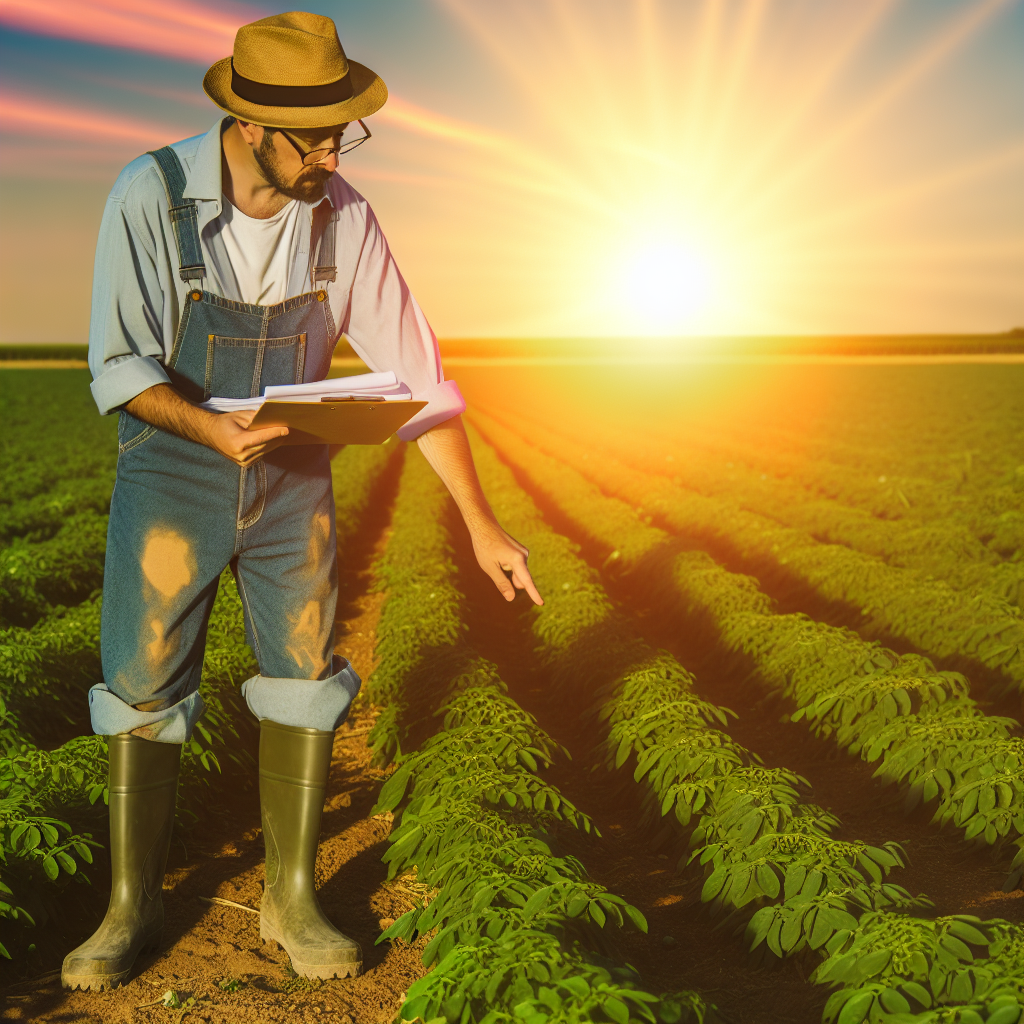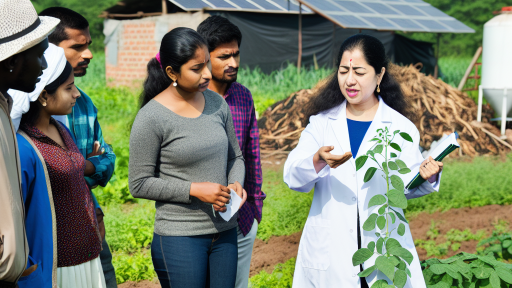Understanding the Relationship Between Water Availability and Crop Yield
The Importance of Water in Agriculture
Water serves as a fundamental resource for agricultural production.
It sustains plant life and supports crucial growth processes.
Moreover, sufficient water availability enhances crop yield significantly.
Without adequate water, plants cannot reach their full potential.
Factors Influencing Water’s Impact on Crop Yield
Various factors determine how water availability affects crop yield.
Soil type plays a critical role in water retention capabilities.
Additionally, crop species vary in their water needs and tolerance.
Weather patterns also influence the amount of water plants receive.
Furthermore, irrigation methods can optimize water usage in agriculture.
Efficient Water Management Strategies
Farmers can adopt several strategies to maximize water efficiency.
Firstly, drip irrigation minimizes water waste and targets roots directly.
Secondly, mulching reduces surface evaporation, conserving moisture.
Planting drought-resistant crop varieties can also be beneficial.
Lastly, rainwater harvesting allows effective use of natural precipitation.
Measuring Crop Yield Under Varying Water Conditions
Monitoring crop yield under different water scenarios provides valuable insights.
Transform Your Agribusiness
Unlock your farm's potential with expert advice tailored to your needs. Get actionable steps that drive real results.
Get StartedField trials help determine optimal watering schedules for specific crops.
Utilizing soil moisture sensors improves decision-making for irrigation.
Regular assessments can highlight the relationship between water and yield.
Finding Balance for Sustainable Agriculture
Finding a balance between water availability and crop yield is crucial.
Farmers must adapt practices that optimize both resources and production.
In doing so, sustainable agriculture can continue thriving amidst challenges.
Evaluating Soil Moisture Retention Techniques
Importance of Soil Moisture
Soy moisture significantly influences crop growth and yield.
Adequate moisture promotes healthy root development in plants.
Conversely, insufficient moisture stresses crops and reduces yield.
Therefore, improving soil moisture retention is essential for maximizing productivity.
Traditional Techniques for Moisture Retention
Farmers often use mulching to help with moisture retention.
This technique involves covering the soil surface with organic or inorganic materials.
Mulch reduces evaporation and keeps the soil cooler.
Furthermore, it suppresses weed growth, allowing crops to thrive.
Modern Techniques and Innovations
Recent advancements offer new moisture retention strategies for farmers.
For example, biochar has emerged as an effective soil amendment.
This carbon-rich material improves soil structure and moisture retention.
Additionally, it enhances nutrient availability for plants.
Implementing Engineered Solutions
Another innovative approach involves using soil moisture sensors.
These devices help monitor moisture levels in real-time.
Farmers can irrigate more efficiently based on accurate data.
As a result, they save water and increase crop yields.
Cover Cropping Practices
Cover crops play a vital role in retaining soil moisture.
They protect the soil from erosion and improve organic matter content.
Showcase Your Farming Business
Publish your professional farming services profile on our blog for a one-time fee of $200 and reach a dedicated audience of farmers and agribusiness owners.
Publish Your ProfileMoreover, cover crops enhance soil structure and water infiltration.
Thus, implementing cover crop practices can lead to better moisture retention.
Challenges and Considerations
While soil moisture retention techniques are beneficial, challenges exist.
For example, the initial cost of implementing new technologies can be high.
Furthermore, farmers may need training to utilize these techniques effectively.
Consequently, assessing the feasibility of new methods is crucial.
Tailoring Solutions to Specific Environments
Each farm presents unique challenges regarding soil moisture retention.
Climate, soil type, and crop selection influence which techniques work best.
Therefore, farmers should conduct thorough assessments before implementing changes.
Customizing strategies to fit specific environmental conditions is vital.
Implementing Efficient Irrigation Systems
Understanding Drip Irrigation
Drip irrigation delivers water directly to the roots of plants.
This targeted approach minimizes evaporation and runoff.
Farmers can save water, even in arid regions.
Additionally, drip systems reduce weed growth.
This method promotes healthier crop production overall.
Farmers often report higher yields with less water usage.
Exploring Sprinkler Irrigation
Sprinkler irrigation mimics natural rainfall.
It evenly distributes water over a wide area.
This method works well for various types of crops.
Farmers can automate sprinkler systems for convenience.
However, it may lead to more water loss through evaporation.
Overall, sprinkler systems can cover large fields quickly.
Comparing Drip and Sprinkler Systems
Both systems have distinct advantages and disadvantages.
Drip irrigation is more efficient in terms of water usage.
On the other hand, sprinklers are easier to manage.
Farmers must assess their specific needs when choosing.
Cost, crop type, and climate all play important roles.
Ultimately, both methods can effectively maximize crop yield.
Making the Right Choice for Your Farm
Begin by evaluating your farm’s water resources.
Consider the types of crops you wish to grow.
Additionally, think about your budget and labor availability.
By assessing these factors, you can make an informed decision.
Combining both systems in some cases may be effective.
Strive for a balanced approach to maximize yield sustainably.
See Related Content: Agricultural Trade Policy Best Practices
Selecting Drought-Resistant Crop Varieties for Better Yield
Importance of Drought-Resistant Varieties
Drought-resistant crop varieties offer essential benefits in water-limited conditions.
These crops require less water, ensuring survival during dry spells.
Farmers can rely on them to maximize yield under challenging circumstances.
Additionally, they often exhibit improved disease resistance.
As a result, farmers can achieve stable production even during adverse weather.
Showcase Your Farming Business
Publish your professional farming services profile on our blog for a one-time fee of $200 and reach a dedicated audience of farmers and agribusiness owners.
Publish Your ProfileIdentifying Suitable Varieties
To select appropriate drought-resistant varieties, farmers must consider various factors.
Climate adaptability is paramount for successful growth.
Additionally, local soil types influence crop selection.
Farmers should also evaluate yield potential against water usage.
Consulting local agricultural extension services can provide valuable insights.
Examples of Drought-Resistant Crops
- Sorghum is known for its drought tolerance and high yield.
- Finger millet thrives in arid conditions while offering nutritious grains.
- Teff is another excellent option, favored for its resilience.
- Cowpeas can also withstand periods of water scarcity and enrich soil.
Each of these crops contributes to food security and sustainable farming practices.
Implementing Effective Strategies
Farmers should integrate conservation practices that enhance soil health.
For instance, cover cropping can improve soil moisture retention.
Minimizing tillage reduces erosion and enhances water availability.
Moreover, using mulches can help retain moisture in the soil.
These strategies boost the effectiveness of drought-resistant crops.
Research and Development Opportunities
Ongoing research plays a critical role in developing new varieties.
Partnerships between universities and agricultural firms yield promising results.
Innovative breeding techniques can produce crops with enhanced resilience.
Investing in research ensures farmers have access to cutting-edge solutions.
Ultimately, these efforts can lead to increased productivity while conserving water resources.
Uncover the Details: Compliance with Export Regulations
Utilizing Cover Crops and Mulches to Enhance Water Conservation
Importance of Water Conservation in Agriculture
Water conservation plays a critical role in sustainable agriculture.
Efficient water use directly impacts crop yield and farm profitability.
Farmers face increasing challenges due to climate change and water scarcity.
Benefits of Cover Crops
Cover crops improve soil health and structure significantly.
They increase organic matter and enhance water retention in the soil.
Additionally, cover crops reduce soil erosion during heavy rains.
Crop diversity from cover crops helps suppress weeds effectively.
Farmers often report improved nutrient availability due to cover crops.
Types of Cover Crops
Different cover crops serve various purposes in water conservation.
- Leguminous cover crops fix nitrogen and enrich the soil.
- Grasses, like rye or oats, establish strong roots that protect soil.
- Brassicas, such as radishes, break up compacted soil layers.
Mulches: A Protective Layer
Mulching is another effective method for conserving water.
Organic mulches like straw or wood chips add nutrients as they decompose.
They also regulate soil temperature, promoting healthy root development.
Furthermore, mulches minimize evaporation from the soil surface.
This results in a more consistent moisture level for crops.
Types of Mulches
Choosing the right mulch can enhance water conservation efforts.
- Organic mulches help with moisture retention and soil fertility.
- Inorganic mulches, like landscape fabric, prevent weed growth.
- Biodegradable options provide temporary protection while decomposing.
Implementing Best Practices
Farmers should strategically plan cover crop and mulch usage.
Timing is crucial for maximizing benefits from these practices.
Evaluating specific field conditions helps in making informed decisions.
Field monitoring ensures that strategies are effective over time.
Collaborating with agronomists can provide valuable insights.
See Related Content: Water Usage Policies Every Farmer Should Know

Applying Precision Agriculture Technologies to Monitor Water Use
Benefits of Precision Agriculture
Precision agriculture optimizes farming practices through technology.
It enhances productivity while conserving resources.
Showcase Your Farming Business
Publish your professional farming services profile on our blog for a one-time fee of $200 and reach a dedicated audience of farmers and agribusiness owners.
Publish Your ProfileFarmers gain access to real-time data about water usage.
This information allows for informed decision-making.
Monitoring Soil Moisture Levels
Soil moisture sensors provide crucial insights.
These devices measure water content in the soil accurately.
Farmers can adjust irrigation based on sensor data.
This capability prevents overwatering and promotes efficiency.
Remote Sensing Technology
Remote sensing uses satellite images to track crops.
It identifies areas requiring more or less water.
Drones offer a unique aerial perspective of the fields.
They capture high-resolution images for analysis.
Data Analytics and Decision Support
Data analytics plays a vital role in precision agriculture.
Farmers analyze combined data to make effective choices.
Decision support systems enhance strategic planning.
These tools project future water needs based on current usage.
Integration with Irrigation Systems
Smart irrigation systems maximize water efficiency.
They connect with weather forecasts and sensor data.
This connection allows for automated adjustments in watering schedules.
Furthermore, it reduces waste and conserves resources.
Case Studies of Successful Implementation
Many farmers have successfully implemented these technologies.
For example, Greenfield Farms increased yield by 15%.
They monitored moisture levels continuously for optimal irrigation.
Such outcomes demonstrate the value of precision agriculture.
Challenges and Considerations
Adopting these technologies can be costly initially.
Farmers must assess return on investment carefully.
Additionally, training is essential for effective use.
Support from agritech companies aids in overcoming these challenges.
Learn More: Securing Permits for Agricultural Land Use
Integrating Rainwater Harvesting Systems for Supplemental Irrigation
Understanding Rainwater Harvesting
Rainwater harvesting involves collecting and storing rainwater for agricultural use.
This practice reduces dependence on groundwater and surface water sources.
Many farmers benefit from using this sustainable method.
Benefits of Rainwater Harvesting
Integrating rainwater systems offers multiple advantages for crop yield.
It enhances water availability during dry periods.
Moreover, it reduces soil erosion and runoff.
Farmers can achieve better yield consistency throughout growing seasons.
This method also decreases irrigation costs over time.
Designing Rainwater Harvesting Systems
Effective design is key to successful rainwater harvesting.
Farmers should assess their land and rainfall patterns first.
Next, selecting appropriate storage tanks is essential.
Tank size should match the extent of harvestable rainwater.
Additionally, systems must filter debris to ensure clean water.
Showcase Your Farming Business
Publish your professional farming services profile on our blog for a one-time fee of $200 and reach a dedicated audience of farmers and agribusiness owners.
Publish Your ProfileImplementing Rainwater Harvesting
Implementation requires careful planning and commitment.
Farmers can start by establishing collection surfaces such as roofs.
Building gutters will direct rainwater to storage tanks.
Regular maintenance is necessary to keep systems functional.
Real-World Examples
Various farms successfully utilize rainwater harvesting systems.
The Green Acres Farm in California increased yield by 30% using this method.
Similarly, the Oak Valley Farm saw a dramatic reduction in irrigation costs.
Challenges and Solutions
Despite numerous benefits, challenges exist with rainwater harvesting.
One common issue is inconsistent rainfall in certain regions.
Farmers can overcome this by integrating supplemental irrigation techniques.
Additionally, educating farmers on maintenance practices is vital.
Future of Rainwater Harvesting in Agriculture
As climate change affects weather patterns, innovative practices become crucial.
Rainwater harvesting systems will play a key role in sustainable farming.
Investment in technology and education will enhance adoption rates.
Ultimately, this will lead to increased food security for generations.
Practicing Crop Rotation and Diversification to Improve Resilience
Introduction to Crop Rotation
Crop rotation involves alternating the crops grown in a field over time.
This method prevents soil depletion and boosts nutrient availability.
By rotating crops, farmers can disrupt pest and disease cycles effectively.
Overall, this leads to healthier plants and increased yields.
Benefits of Crop Diversification
Diversifying crops enhances resilience against environmental stresses.
It reduces reliance on a single crop, spreading risk across the farm.
Additionally, it fosters a more balanced ecosystem in agricultural areas.
Farmers can benefit from different market trends with a varied crop selection.
Choosing Compatible Crops
Selecting compatible crops is crucial for effective rotation and diversification.
Some crops improve soil health, while others may attract beneficial insects.
Legumes, for instance, fix nitrogen in the soil, enhancing fertility.
Incorporating cover crops protects soil from erosion and improves moisture retention.
Implementing a Rotation Schedule
A well-planned rotation schedule maximizes productivity while conserving resources.
Farmers should map out which crops to plant each season ahead of time.
Spacing out similar crops can minimize the buildup of specific pests.
Regularly reviewing and adjusting the schedule keeps it effective over years.
Case Studies of Successful Crop Rotation
Many farmers worldwide demonstrate the benefits of crop rotation.
For example, Sarah Thompson in Iowa successfully rotated corn and soybeans.
This practice led to a significant reduction in pest issues and higher yields.
Similarly, Jake Martinez in California uses a mix of grains and legumes to improve soil structure.
Sustainable Farming Practices for the Future
Crop rotation and diversification offer promising solutions for sustainable farming.
Farmers can achieve greater resilience and productivity with these practices.
Focusing on long-term soil health benefits not only crops but the environment.
Continuous education on best practices will help farmers adapt to changing conditions.
Additional Resources
Soil Health | Natural Resources Conservation Service
Showcase Your Farming Business
Publish your professional farming services profile on our blog for a one-time fee of $200 and reach a dedicated audience of farmers and agribusiness owners.
Publish Your ProfileResearch Programs and Projects at this Location : USDA ARS




